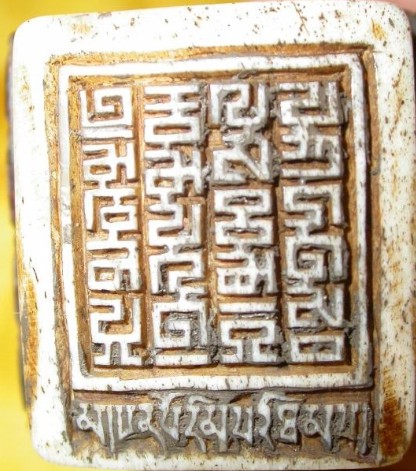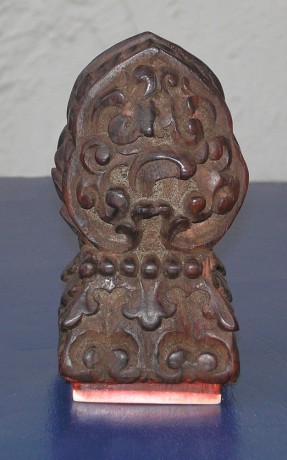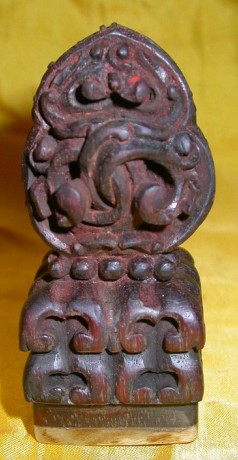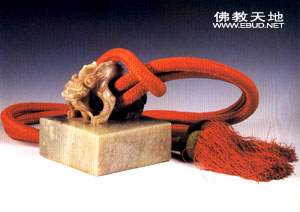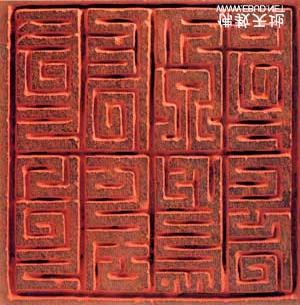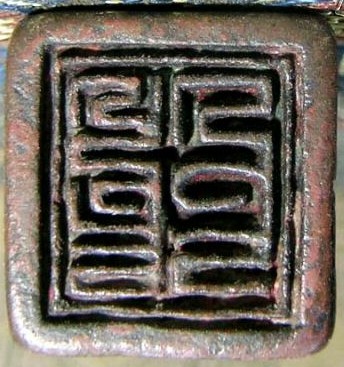BabelStone Blog
Sunday, 13 January 2008
Caveat Emptor : A Buyers' Guide to Seals
Every now and then people ask me for advise about some fine object that they have bought on ebay, and usually it makes me glad that my job does not pay me enough to develop an ebay habit. But just in case any of my more affluent readers are tempted to start collecting antique Chinese or Tibetan seals, I thought that it might be useful to take a look at three seals that I have recently seen for sale :
- Wonderful Amazing Old Tibet Carved Wooden Ivory Seal NR by east-online @ $399
- Very Lg. Chinese Imperial Seal(Chop)- Yuan -1279-1368AD by JJ Oriental @ $950
- Very Rare!Yuan Dyn. Phags-pa & Chinese script Seal XF by Only Linda @ $1,200
Not the Seal of the Imperial Preceptor of the the Great Yuan Dynasty
The first seal is described as an old carved wooden and ivory seal that the seller acquired directly from a Tibetan family in the Ali region of Tibet. The image of the seal face on the seller's site shows the inscription to be in the Tibetan style of Phags-pa script (hor yig) with one line of Tibetan script below (image has been mirrored to make it easier to read) :
The quality of both the Phags-pa inscription and the Tibetan inscription is quite poor, and several of the letters appear to be corrupt. The Phags-pa inscription reads mkhan po --m (rim ?) pa'i las tham [kha ?] bkra shis "Seal of the Abbot ..., good luck" (I'm not quite sure what the first letter of the second column is, and the symbol at the bottom of the third column is perhaps a corruption of kha). The Tibetan text is much the same, reading mkhan po rim pa'i tham ga མཁན་པོ་རིམ་པའི་ཐམ་ག (the letters kha and ga are both corrupt).
It is a little suspect, but this is not actually the seal I want to talk about, so we'll say no more. The strange thing is that when the person who bought this seal opened up the package he found that the seal sent to him (on the left) was not quite the same as the advertised seal (on the right) :
Although the bodies of the two seals are both made of wood and are stylistically very similar, and the seal faces are both (supposedly) made of ivory, their inscriptions are very different indeed. As we have seen, the inscription on the advertised seal is in Tibetan written in the Tibetan style of Phags-pa script, which is found on seals dating from the late 16th century up to the present day. However, the inscription on the seal that the buyer actually received is in Chinese written in the "seal script" style of the Phags-pa script that is found on seals dating from the Yuan (1271-1368) and and Northern Yuan (1368-1402) periods, but rarely any later (image has been mirrored to make it easier to read) :
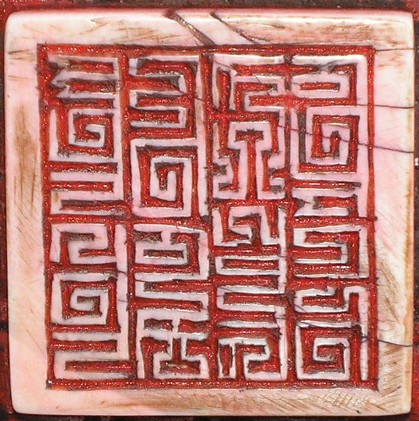
The inscription is very clear and reads thung ling shi gyaw tay 'wen guė shhi, which can be interpreted as a phonetic representation of the Chinese tongling shijiao dayuan guoshi 統領釋教大元國師, meaning "Leader of the Buddhist Faith and Imperial Preceptor of the the Great Yuan dynasty". This is a well-known title that was bestowed by Khublai Khan (reigned 1260-1294) on the Phags-pa Lama (c.1239-1280) and his successors, so if it were genuine it would be a very important historical artefact and extremely valuable.
Unfortunately there are several reasons why it must be a fake, and not worth a penny :
- the lettering, although calligraphically acurate, is extremely crude
- the wooden body of the seal is typical of recent Tibetan seals, but not of seals dating to the Yuan dynasty
- seals bestowed on religious leaders by emperors of the Mongol empire were generally made of precious materials such as gold, silver or jade, and not made from wood
In fact, at least two genuine examples of jade seals dating to the Yuan dynasty, with exactly the same Phags-pa inscription, are known. This one is held at the Tibet Museum in Lhasa (image of seal face has been mirrored to make it easier to read) :
However, our seal most closely matches a seal that is held at the Norbulinka Palace in Lhasa :
The letterforms on our seal exactly match those on the above seal imprint, but are very crudely carved, and we can only conclude that it is a poor imitation of the real thing.
Seal of the Assistant Military Commander
The second seal I want to look at today is a very fine-looking bronze seal that is advertised by the seller as dating to the Yuan dynasty (1271-1368), with a four-character inscription in Chinese "nine-fold" seal script (九叠篆) characters (image of seal face has been mirrored to make it easier to read) :
Well, it certainly does look good to me, although if it is genuine it actually dates to the Jin dynasty (1115-1234) not the Yuan dynasty (1271-1368). The key to dating is the inscription, which reads futongzhiyin 副統之印 "seal of the assistant military commander". The post of assistant military commander (副統) was established in 1215, near the end of the Jin dynasty, and several bronze seals dating to the late Jin dynasty have exactly this inscription (but no Yuan dynasty seals as far as I know) :
- one held at the Palace Museum in Beijing
- one held at Jinzhou City Museum in Liaoning
- one discovered in Dalian in Liaoning
- one discovered in Changle in Shandong in 1984
- one held at the Gaomi Museum in Shandong, with an inscription on the back of it dated Zhenyou 4 (1216)
- two discovered near Harbin in Heilongjiang in 1971 and 1984, both with an inscription on the back dated the Year of the Pig (i.e. 1218 or 1223)
- one discovered near Harbin in Heilongjiang in 1976
- one unearthed at Russian Far East
Although the above list may give the impression that this is a common seal, Jin dynasty bronze seals like this are very rare, and especially hard for the private collector to acquire. In my opinion, the price asked for this seal ($950) is very reasonable if it is genuine, and from the pictures of the seal on the seller's site it does look genuine to me.
The Seal of Long Ying
The third seal is a Yuan dynasty bronze seal with a Chinese inscription in standard Yuan dynasty style Phags-pa script (image of seal face has been mirrored to make it easier to read) :
This is a good example of a Yuan dynasty personal signet seal, which were used by individuals to seal their name on documents. A large number of such seals are known, many of which have the name of their owner engraved in the Phags-pa script or jointly in Phags-pa letters and Chinese characters. The Phags-pa inscription on this particular example reads leung -ing, which is almost certainly a Chinese name, Long Ying (龍/隆 應/英). On the side of the seal are engraved the Chinese characters he tong 合同 "agreement", indicating that the seal was used in sealing agreements.
There is no doubt in my mind that this particular seal is genuine, although I am afraid that it is seriously overpriced.
Index of BabelStone Blog Posts
